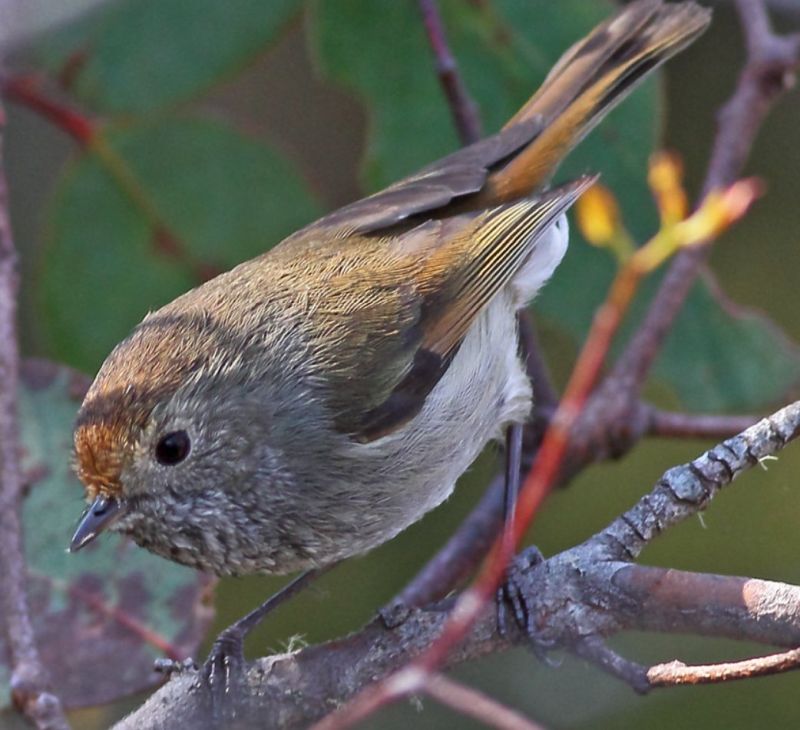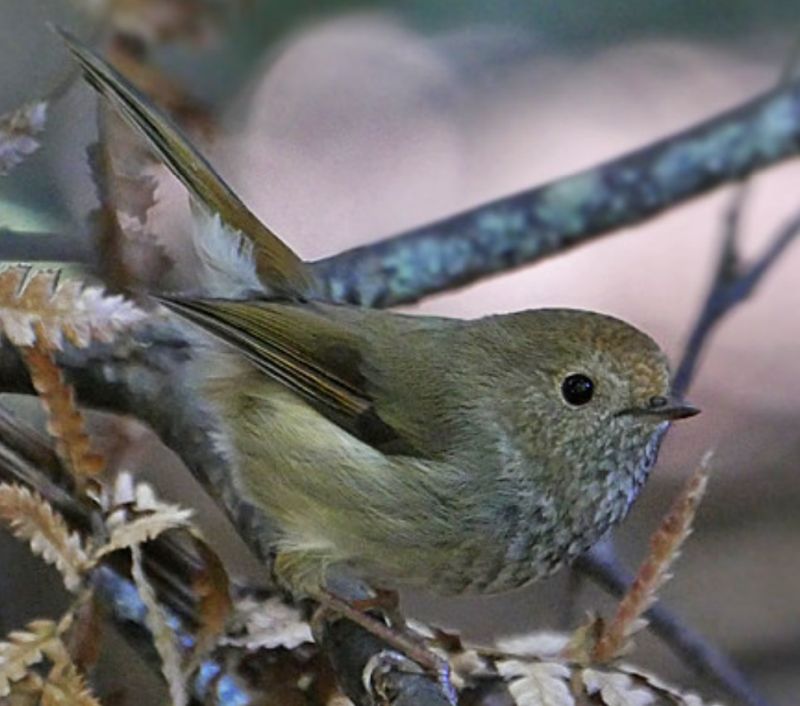Habitat: The Tasmanian Thornbill (Acanthiza ewingii) is found in temperate rainforests and wet sclerophyll shrubberies in Tasmania and islands in the Bass Strait. However, it is also found in Mediterranean-style shrubby vegetation, bogs, marshes, fens, swamps, peatlands, and shrub-dominated wetlands. Here, the bird is hopping and flitting actively and freely throughout the day. In the wet forests, it occurs side by side with two other small, insectivorous ‘warblers’—the scrubtit and white-browed scrubwren—but these generally occupy different feeding zones. The white-browed scrubwren forages in shrubberies near the forest floor, while the scrubtit feeds prefer on the trunks and larger branches of trees.
Identification: Both sexes are similar. The upper parts are generally olive-brown, and the upper tail coverts are washed russet. The wings are dark grey-brown; primaries edged broadly russet, contrasting with black coverts. The tail is dark grey-brown with a black subterminal band and grey-buff tips to inner webs of all but the central pair of feathers. Forehead-washed chestnut, faintly scalloped dusky. The face is grey-brown with lighter flecks and pale grey lores. The throat and breast are grey-white, flecked and mottled dusky grey; lower breast to flanks and belly buff-grey with while center; undertail coverts white. The eyes are red. The bill is dusky black. Feet are dusky brown. The immature (as an adult) is a bit paler. The undertail coverts are grayer. The eyes are dark brown.
Behavior: In winter, these three species form noisy mixed feeding parties that flit and hop locally through the undergrowth, each searching out prey within its niche. Up to 15-20 Tasmanian Thornbills can be present, and their musical twittering mixes confusingly with the calls of the scrubwren and scrubtit. The Tasmanian Thornbill is sometimes found with another closely related insect” eater, the Brown Thornbill, but mostly they live in different habitats.
Distinguishing the Brown Thornbill: The two birds are similar in plumage, but the Tasmanian Thornbill can be distinguished by its more uniformly washed russet forehead. Because its mottled rather than streaked breast, pure white undertail coverts, and a dash of russet-ochre on the flight feathers. The Brown thornbill keeps generally to drier, more open forests and heaths, with little overlap. This is most likely due to the island having been occupied by thornbills from the mainland on various occasions. First came the ancestors of Tasmanian thornbills, at a time when cold, wet forests offered the only niche. Later, the Brown Thornbill arrived to establish itself in drier forests under a warmer climatic regime.
Courtship: During courtship, the male faces its female on perches approximately 30-50 cm apart and bows repeatedly, gently expanding its wings and fanning its tail to expose the terminal pattern.
Diet: The Tasmanian Thornbill is typically arboreal, and it feeds mostly on insects gleaned from the leaves and outer branches of shrubs and trees from a meter up to the forest canopy and rarely visits the ground.
Vocalizations: Tasmanian Thornbill call is thin, reedy, twittered tsirp tsirp, repeated three or four times in contact; soft staccato buzzing, churring in alarm. However, the song is beautifully whistled and twitters, often starting with a contact call followed by a short, swirled metallic trill. Its main call has been described phonetically as a zit-zit-zit sound
Nesting and Breeding: Tasmanian Thornbill nesting and breeding occur in September–January. Nest a compact dome with an open side entrance near the top of grass, bark, and moss bound with cobweb, lined with fine grass and a thick mat of feathers and fur, hung by the top from a thin twig in the outer foliage or branches of a small tree or shrub, usually 2-4 meters above ground, rarely to 8 meters.
Eggs: This thornbill species lays 3 to 4 eggs, pinkish white, finely speckled with red-brown, mainly at the larger end; oblong-oval, size 18 x 13 mm. It is unknown how long these eggs took to fully incubate or how long it takes for them to hatch and become independent.
Distribution: Tasmanian Thornbill is found commonly in the wet sclerophyll forest and temperate rainforest throughout Tasmania, particularly in the west. Also in wet gullies in dry sclerophyll forests and coastal heathland, on the King, Flinders, and Maria Islands.
Alternative Names: It is also known as Ewing’s Thornbill and Ewing’s Tit.
Size: The Tasmanian Thornbill measures about 100–105 mm in length.
Races: There are no races.
Status: It is common and widespread in its habitats, so least concern on the IUCN list.
Family: The Tasmanian thornbill is a little bushland Acanthizidae (Australian warbler) family member.
Domain: Eukaryota
Order: Passeriformes
Kingdom: Animalia
Featured bird groups: Small insect-eating birds
Phylum: Chordata
Class: Aves
Genus: Acanthiza
Atlas Number: 473
Species: A. ewingii
Read More: Yellow-throated Honeyeater (Nesoptilotis flavicollis)








